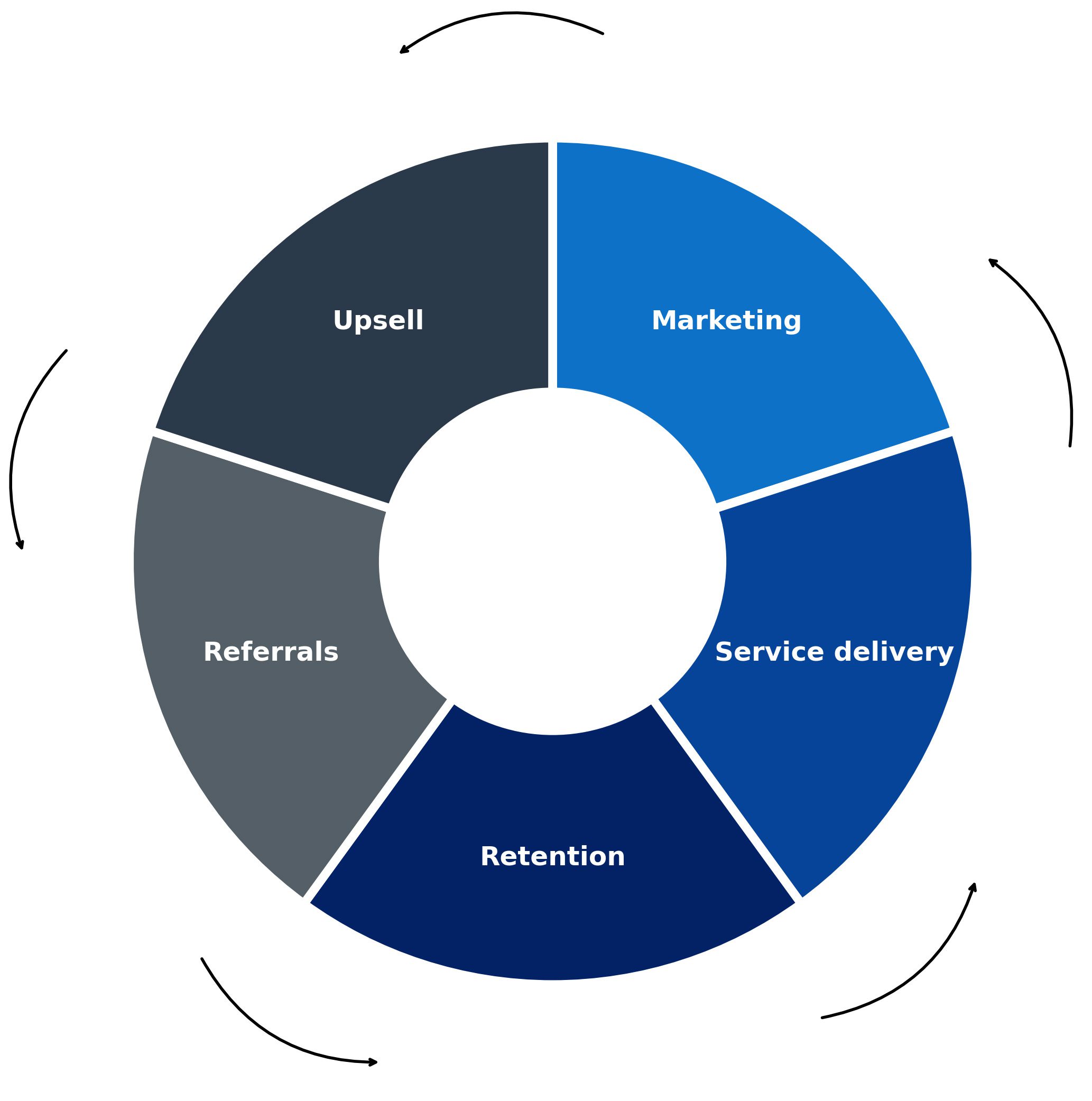If you are an HVAC business owner ready to scale, it’s likely that your current system needs an upgrade. ✅
Perhaps you are experiencing an increase in demand that your current team can’t keep up with. Or maybe you want to expand geographically or increase your capacity for larger projects. Whatever the case may be, this means adopting the right systems and processes to facilitate these changes.
If this sounds like you, you may be wondering where to start. For businesses on the move, having the proper platform to manage operations makes all the difference.
Here at Method CRM, we’ve been supporting QuickBooks-based businesses since 2010. Method is loved by HVAC companies for its real-time, two-way QuickBooks sync, end-to-end sales automation, and customization services. Method CRM for field services also offers a Field Crew app that keeps service techs and office staff in sync.💯🎯📈
In this guide, we highlight relevant tools and break down the practical strategies for growing an HVAC business, from planning to execution.🚀
Table of Contents
Why many HVAC businesses stall and how to avoid it ❌
Running an HVAC business isn’t easy, and there are common challenges that can stall you. Spotting these ahead of time can help you keep your business moving.
Here are some common reasons why HVAC business growth often comes to a halt:
- ❄️ Seasonal dips: HVAC work naturally fluctuates depending on the season. Heating services often spike in winter, and cooling services during the summer. Spring and fall are often quieter. These off-peak months can create gaps in revenue and underused crews. To avoid this, plan seasonal promotions (like pre-summer AC checkups or winter furnace inspections) or schedule tune-ups to fill slow periods.
- 🚫 Lack of systems: Without an organized business operation, jobs slip through the cracks, schedules get mixed up, and growth comes to a standstill. To avoid this, establish standard workflows, use software to track jobs and customer information, and create easy-to-follow systems that keep your team on the same page.
- 🤯 Owner burnout: Running every part of the HVAC business yourself isn’t realistic. When you’re exhausted, mistakes happen, and you miss opportunities. Prevent possible burnout by delegating responsibilities, assembling a reliable team, and automating repetitive tasks.
Growing a business is a continuous cycle, as shown in this growth flywheel. It’s a systematic effort that takes careful planning.

Here’s how the growth flywheel works:
- Start by finding ways to attract potential customers.
- Deliver exceptional HVAC services that turn them into satisfied customers.
- Keep customers coming back with retention strategies.
- Encourage referrals to bring in even more business.
- Offer upgrades or additional services to increase revenue per customer.
- Repeat the cycle.
Each stage feeds the next, creating momentum. The more efficiently your flywheel spins, the less you’ll have to chase leads manually and the more predictable your growth becomes.
Define your growth foundation 🌱
Before chasing growth, you’ll first need to build a foundation for your business. A strong base prevents chaos as you scale and prepares you to handle the extra workload.
Here are strategies on how to lay the groundwork for lasting business growth.
1. Choose your ideal HVAC customer segments 👥
You can’t make everyone your customer, as it’ll spread your business too thin.
Your customer segments define the type of work you’ll do and how you’ll market your services. Make sure you and your team’s HVAC licenses cover your chosen markets.
These are the core HVAC customer segments to focus on:
- 🏠 Residential: Focus on homeowners who need repairs, maintenance, or upgrades like air conditioning replacement or duct cleaning. It’s a great niche for steady, routine work and strong local visibility.
- 🏢 Commercial: Work with offices, retail spaces, or buildings that need larger-scale systems and ongoing maintenance. You’ll see a higher revenue per job, but often with slower decision cycles.
- 🏗️ New construction: Partner with builders for system installs in new builds. This model is predictable but also competitive, as it requires precise scheduling and coordination from multiple teams.
2. Pricing, margins, and financial benchmarks 💰
Understanding your costs, knowing your margins, and providing accurate estimates for your HVAC jobs keep your business afloat. Also consider offering service contracts for a steady revenue stream during the slower months, while also building long-term trust with clients.
Aim for profit margins that support growth. For small businesses, a 10–20% margin after expenses is considered healthy. Then set aside around 6–12% of your annual revenue for growth efforts.
For instance, if your HVAC company brings in $800,000 a year, you could reinvest $48,000–$96,000 in new email marketing campaigns, improving your fleet, or boosting your online presence with Google ads.
3. Map out a 90‑day growth plan ✍🏻
Every successful HVAC business runs on a plan. After all, guesswork won’t help you thrive. Having a growth plan gives your new business structure, focus, and measurable progress. Think of it as your short-term roadmap for hitting realistic targets.
Here’s an example of how a 90‑day growth plan goes:
- Month 1 – Foundation: Define your target market, review your pricing structure, and set up your apps and CRM.
- Month 2 – Promotion: Launch a local marketing campaign while also boosting brand awareness on social media. Send out flyers to your local service areas. Gather early customer reviews to build trust.
- Month 3 – Results: Track leads, conversions, and bookings to see how things went. Refine what worked and cut what didn’t. Roll out a referral program to bring in more jobs.
Pro tip! Set specific milestones in your plan, like setting up your marketing channels in month one and launching your first full campaign in month two, to keep your growth on track every 30 days.
Marketing strategy that drives qualified leads 📊
Once your foundation is in place, it’s time to get noticed. From optimizing your content for local SEO to going on social media, the right approach gives you quality leads who are ready to book.
These are the marketing strategies that will help you reach potential clients actively searching for HVAC services.
4. Local SEO and website optimization 👨🏻💻
With strong local SEO, your HVAC business will show up when people search for services nearby. The goal of localizing your SEO is to rank in your service area and earn trust locally.
Of course, discovery is only half the battle. Once visitors land on your site, you’ll need to optimize your website to provide a great user experience. This includes having clear calls-to-action, fast-loading pages, and an overall intuitive website.
Focus on these areas to strengthen your website’s SEO performance:
- 👨🏻💻 On-page SEO: Build service pages like “air conditioning repair in Dallas.” Use city + keyword targeting in titles, meta tags, and headers.
- 🌐 Technical SEO: Keep your website fast and mobile-friendly. Improve Core Web Vitals (loading speed, interactivity, and visual stability) and add schema markup (service type, pricing, and customer ratings) for commercial/home services to help Google understand your pages.
5. Google Business Profile and Local Pack 🗺️
Your Google Business Profile (GBP) is your HVAC company’s online storefront. It shows your name, address, phone number, reviews, and hours right in the search results. And if you properly optimize your GBP, you’ll get to be in Google’s Local Pack, which is a coveted top-three map listing that customers see first on the search results page.
To achieve this, you need to claim your GBP. Fill out every field, add photos, and post updates regularly.
You can also boost your visibility with Google Local Services Ads (LSAs) and pay-per-click (PPC) campaigns. LSAs put your business above organic results, and you pay for every lead you get. PPC ads, on the other hand, let you bid on keywords like “AC installation near me,” so your ad shows up when someone searches for it. You then only pay when someone clicks your ad.
Think of your GBP as owning prime real estate on Google. When potential customers search for HVAC help, your business appears front and center. That’s when investing in LSAs and PPC ads pays off.
6. Content and inbound marketing 📝
Content marketing focuses on sharing helpful resources, like blogs, videos, and social posts, that answer real HVAC questions. It’s part of inbound marketing, which is a broader strategy that pulls in customers with relevant content.
So instead of chasing leads via cold calls or hard sells, you attract potential clients who are already searching for HVAC help.
Here are ways to start your content and inbound marketing efforts:
- 📰 Blogging/FAQ pages: Cover common, relatable topics optimized for keywords your customers search for like “Why is my AC leaking?” or “When to replace a furnace.”
- 🎥 Video marketing: Record quick maintenance tips, behind-the-scenes clips of your HVAC technicians at work, or testimonials to show customer satisfaction.
- 🤳 Social media marketing: Use various social media platforms, such as Facebook, Instagram, YouTube, and TikTok, to showcase your work, like before-and-afters.
7. Paid Promotions and Ads 📣
Paid ads and promos are some of the fastest ways for HVAC businesses to drive traffic and bookings. You’re paying for visibility, but when your targeting and messaging are right, there can be a significant return on that investment.
Here are a few paid marketing tactics to try:
- 📲 Facebook/Instagram ads: Target homeowners and businesses nearby with seasonal offers or service reminders.
- 🖥️ Google PPC campaigns: As mentioned, you can run ads for specific search terms related to your niche. Add retargeting to re-engage past visitors.
- 📩 Direct mail or local promotions: Send postcards or flyers in high-ROI neighbourhoods, especially before peak seasons.
Referrals and reviews ⭐
Word-of-mouth is gold in the HVAC industry. Ads can attract leads, but real trust is built through genuine customer experiences. So what better way to prove your quality and reliability than having a satisfied client vouch for you?
Fuel trust-building through active referral and review programs. Learn how these strategies work below.
8. Systematize referrals from existing customers 🗂️
A referral program turns trust into a repeatable process.
Here’s a quick overview of how to structure your referral program:
- ⭐ Reward: Set your incentive, like a $50 credit or free maintenance check, for every successful referral.
- 📃 Terms: Provide simple, transparent rules (like a reward that applies once the new client books and completes a service).
- 📍Tracking: Use your CRM to log who referred whom and monitor the payouts automatically.
Pro tip: The best time to ask for referrals is after a job well done, right when customer satisfaction is still high. After a clean install or repair, have your HVAC professional thank the customer and send a follow-up email with a referral link.
9. Encourage and collect online reviews 👏
Online customer reviews act as social proof that your HVAC business delivers. They help boost your credibility and help your Google Business Profile rank higher.
Make it easy for happy customers to leave feedback. You can send review requests via email or SMS, or include a review link in your invoices. Personalize the message and thank them for their business before asking for honest feedback.
Once received, display the reviews on your website, marketing materials, and social posts. If you get a negative review, don’t worry. It happens to everyone. Just reply calmly, acknowledge the concern, and explain how you’re going to address it.
10. Partnerships and cross-promotions 🤝
HVAC contractors thrive on local connections. You can build partnerships with other service providers in your community for steady referral streams.
Here are ways to connect with local partners for growth:
- 👨🔧 Partner with realtors, plumbers, electricians, or home builders: Exchange referrals for clients moving into new homes or starting renovations.
- 🔥 Host joint promotions: Pair up with a local contractor for limited-time deals, like an “AC + insulation tune-up package this summer.”
- 🎁 Bundle services: Team up with other trades for standard bundled home maintenance plans. For example, you could offer a year-round home maintenance plan that includes HVAC, plumbing, and electrical checkups.
- ✨ Sponsor local events: Support community fundraisers or sports teams to increase brand awareness and goodwill.
Operational excellence and automation 🏆
A smooth operation is key to a successful HVAC business. With tools and systems to handle the repetitive work, you can optimize your operations and deliver consistent service that keeps customers satisfied and coming back.
Run your business like clockwork with these strategies.
11. Dispatch, scheduling, and CRM systems 🗓️
Purely relying on manual processes slows growth. Scheduling software and CRM systems let HVAC businesses run efficiently by dispatching jobs and coordinating office staff, service techs, and field operations in real time.
Some tools combine all of these functions into a single platform, like Method CRM for field services. As an all-in-one QuickBooks-compatible field service management solution, you get to manage dispatch, scheduling, customer data, and billing seamlessly. No need to keep track and switch between multiple apps.
Here’s what you can expect when using Method CRM for field services:
- 🔄 Two-way QuickBooks integration: Sync invoices and payments effortlessly. Your accounting stays accurate without any extra work.
- 💻 All-in-one dashboard: View your technicians’ schedules, current job statuses, metrics, and tasks at a glance.
- 📅 Automated routing and scheduling: Assign the nearest available tech to each job and calculate the fastest route.
- 👨💼 Customer management: Track service history, upcoming follow-ups, and maintenance agreements, so every client interaction is logged and nothing falls behind.
With the right tools and software that integrates smoothly with your existing systems, you can run your HVAC business efficiently, reduce errors, and keep both your team and customers on the same page.
12. SOPs and training 📄
Standard Operating Procedures (SOPs) are written guides that outline how your techs handle jobs, customer interactions, and safety protocols. They’re essential, especially when onboarding new team members and maintaining consistent service quality.
Once you have these, you can pair your SOPs with ongoing training and feedback loops to reinforce best practices.
For example, after a new tech completes an AC install, your manager reviews the tech’s work using SOPs, provides feedback, and tracks improvements over time. This keeps work standards high, reduces mistakes, and improves customer satisfaction.
13. Customer communication and retention tactics 🗣️
How you interact with your HVAC customers, through calls, emails, texts, or in-person updates, directly affects whether they’ll stick with your business and book future services.
Here are some retention tactics to keep your customers engaged:
- 📑 Maintenance agreements: Scheduled tune-ups that guarantee recurring business.
- 📧 Drip email campaigns: Send helpful reminders, seasonal offers, or system alerts.
- ⬆️ Upsell opportunities: Promote IAQ products, smart thermostats, or upgrades to increase the value of each job.
- 👋 Follow-ups and check-ins: Call or email after service to ensure that the customer is satisfied, or to address any questions or concerns promptly.
Putting it all together: Growth playbook 📈
Your HVAC business grows fastest when every strategy feeds the next.
More leads → more jobs → more referrals → retention
Here’s how you can map out your business’s growth journey:
- Attract more leads through effective marketing strategies.
- New leads turn into more jobs, keeping your techs busy and your business growing.
- By providing top-notch service, you get happy customers who will recommend you, leading to more referrals.
- With referrals, you retain customers and increase repeat business.
KPIs for HVAC businesses 👨🔧
Don’t forget about the metrics that matter to your business. These key performance indicators (KPIs) show whether your growth strategies are working:
- Lead conversion rate: Number of leads that become customers.
- Average job value: Revenue per service call.
- Customer lifetime value: Total revenue from a customer over time.
- Referral rate: Number of new customers from word-of-mouth/referrals.
Growth forecast model 🚀
A growth forecast predicts your business’s revenue, leads, and jobs based on your marketing and operational capacity. It shows you what to hire for, where to invest, and how to expand.
A sample 12-month HVAC growth forecast looks like this:
| Quarter | Leads | Conversion rate | Jobs booked | Avg job value | Projected revenue | Notes |
| Q1 | 150 | 40% | 60 | $500 | $30,000 | Foundation & early marketing campaigns |
| Q2 | 360 | 45% | 162 | $520 | $84,240 | Seasonal AC prep, service contracts upsells |
| Q3 | 420 | 50% | 210 | $550 | $115,500 | Peak summer, retention and referrals active |
| Q4 | 210 | 42% | 88 | $520 | $45,760 | Fall/winter prep, off-peak maintenance focus |
Here’s how to use the forecast:
- Compare the projected versus actual leads and revenue each quarter.
- Adjust marketing, staffing, and promotions based on the results.
- Include your repeat customers and referrals to predict what’s sustainable.
- Tie into your HVAC service software for automated tracking and KPI monitoring.
This only serves as a blueprint. Include the metrics relevant to your business and track your results regularly, such as on a monthly basis. Tweak your marketing and retention efforts, and update projections as your HVAC business evolves.
With consistent monitoring, you’ll always be confident knowing where to hire, spend, and grow.
Common mistakes and troubleshooting ⚠️
Having more jobs won’t always mean more profit if you don’t have the proper systems in place.
Here are some common mistakes when scaling your HVAC business and how to troubleshoot them:
- 💸 Overspending on ads without the foundational elements: Running campaigns without a clear target market, pricing, or website setup wastes money. Don’t jump into advertising without solidifying your growth foundation first.
- 🙉 Ignoring seasonal downturns and cash flow: HVAC demand fluctuates with the seasons. To keep cash flow steady, plan for off-peak months with promotions, maintenance contracts, or tune-ups.
- 🤦♂️ Poor lead quality or no follow-up: Leads are only valuable if you act on them. Use follow-up systems, email reminders, or call scripts to nurture inquiries into booked jobs.
- 👎 Underutilized referrals: Your customers are a powerful source of new business. Create a simple referral program and ask for referrals after successful jobs.
- 📈 Scaling too fast without process stability: Expanding before SOPs, training, and scheduling systems are in place leads to chaos. Build your processes, then grow steadily.
Summary and next steps ➡️
To recap, growing your HVAC business relies on four main levers:
- 📢 Marketing: Attract new leads with targeted campaigns and local visibility.
- ⚙️ Operations: Streamline scheduling, dispatch, and service delivery for efficiency.
- 🤝 Referrals: Turn your satisfied customers into a steady source of new leads.
- 🙋♂️ Retention: Keep clients coming back through various retention tactics.
Start with your foundation, which sets up your operations and processes. Then, layer in marketing, referrals, and retention strategies to support sustainable growth.
A field service platform brings everything under one roof. Method CRM for field Services handles job scheduling, dispatch, follow-ups, and invoicing, all synced instantly with QuickBooks. With Method, your team spends less time juggling tasks and more time growing the business.
Start your free trial with Method today and start taking full control of your HVAC business.
Frequently asked questions
How can I differentiate my HVAC business from competitors?
Focus on what makes your HVAC business unique. Offer a few key services and do them exceptionally well. Satisfied clients will naturally recommend your services, helping your business stand out. Combine that with community involvement to increase local visibility and build trust. Then, showcase your expertise with online reviews and testimonials to reinforce your reputation.
Together, these steps create a unique, memorable HVAC brand that customers recognize and prefer over competitors.
How do I get more customers for my HVAC business?
Start with a solid marketing plan. Include strategies like optimizing for local SEO, updating your Google Business Profile, and running targeted ads such as Google PPC or social media campaigns. Encourage referrals and ask happy customers to leave reviews. Offer seasonal promotions or maintenance contracts to keep work steady, and stay active on social media to boost brand awareness.
Combine these with smooth customer communication and follow-ups to turn leads into loyal clients.
How profitable is an HVAC business?
A well-run HVAC business can be highly profitable. Healthy profit margins are typically 10–20% after expenses, and reinvesting 6–12% of revenue into growth (marketing, new equipment, or tech) keeps momentum going.
Profit depends on your service mix, pricing, and efficiency. Seasonal planning, retention strategies, and using the right tools for scheduling and billing all contribute to stronger margins and sustainable growth.






